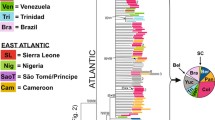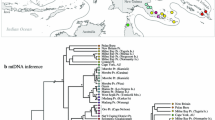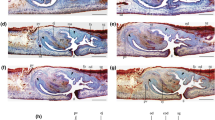Abstract
The invasive land snail Theba pisana pisana has been widely dispersed through human activities. The Mediterranean and adjacent Atlantic coasts are considered as natural range of this species, which also occurs northwards to the Netherlands, the British Islands and in Ireland. In addition, T. p. pisana has been introduced to some Macaronesian Islands as well as to Argentina, Australia, South Africa, and the United States. One important part of understanding biological invasions is the history of the processes including the routes of spread and introduction. Reconstructing the phylogeography based on COI sequences, we asked to which extent it may still be possible to trace natural as opposed to human causes for the current distribution. In addition, we attempted to infer the origins of the apparently recent human-mediated introductions. Tree reconstructions and demographic analyses showed that apart from the origin in NW-Africa, where T. p. pisana already underwent considerable differentiation, and an initial spread to the Iberian Peninsula, the phylogeographic signal was largely blurred. All available evidence indicated that primarily human activities rather than natural causes have shaped and still shape the current distribution. Already the spread through the Mediterranean basin may be anthropogenic and even the origins of our samples from South Africa and Australia could not unambiguously be traced. One clade was geographically particularly diverse suggesting that different lineages differ in their adaptive and invasive potential.







Similar content being viewed by others
References
Adam W, Leloup E (1937) Sur la presence de Helicella virgata (Da Costa) et Theba pisana (Müller) en Belgique. Bull Mus Royal d’Hist Nat Belg 13:1–8
Arnaud J-F, Madec L, Guiller A, Deunff J (2003) Population genetic structure in a human-disturbed environment: a case study in the land snail Helix aspersa (Gastropoda: Pulmonata). Heredity 90:451–458
Arter HE (1990) Spatial relationship and gene flow paths between populations of the alpine snail Arianta arbustorum (Pulmonata: Helicidae). Evolution 44:966–980
Baker GH (1991) Production of eggs and young snails by adult Theba pisana (Müller) and Cernuella virgata (da Costa) (Mollusca: Heliciae) in laboratory cultures and field populations. Aust J Zool 39:673–679
Barker GM (2002) Molluscs as crop pests. CABI Publishing, Wallingford
Berthold P (2001) Bird migration. A general survey, 2nd edn. Oxford University Press, Oxford
Cadée GC (1988) Levende wadslakjes in bergeend faeces. Ned Malac Ver 243:443–444
Cameron RAD, Pokryszko BM, Horsák M (2010) Land snail faunas in Polish forests: patterns of richness and composition in a post-glacial landscape. Malacologia 53:77–134
Castillejo J, Seijas I, Villoch F (1996) Slug and snail pests in Spanish crops and their economical importance. In: Henderson IF (ed) Slug and snail pests in agriculture. British Crop Protection Council, Farnham, pp 327–332
Chace EP (1915) Helix pisana Müller in California. Nautilus 29:72
Ciosi M, Miller NJ, Kim KS, Giordano R, Estoup A, Guillemaud T (2008) Invasion of Europe by the western corn rootworm, Diabrotica virgifera virgifera: multiple transatlantic introductions with various reductions of genetic diversity. Mol Ecol 17:3614–3627
Civeyrel L, Simberloff D (1996) A tale of two snails: is the cure worse than the disease? Biodiv Cons 5:1231–1252
Clement M, Posada D, Crandall KA (2000) TCS: a computer program to estimate gene genealogies. Mol Ecol 9:1647–1660
Connolly M (1916) Notes on the South African non-marine Mollusca. Ann S Afr Mus 13:187–188
Cook LM, Goodfriend GA, Cameron RDA (1993) Changes in the land snail fauna of eastern Madeira during the Quaternary. Trans R Soc Lond B 339:83–103
Cowie RH (1984) The life cycle and productivity of the land snail Theba pisana (Mollusca: Helicidae). J Anim Ecol 53:311–325
Cowie RH (2001) Invertebrate invasions on Pacific islands and the replacement of unique native faunas: a synthesis of the land and freshwater snails. Biol Invasions 3:119–136
Cowie RH, Dillon RT, Robinson DG, Smith JW (2009) Alien non-marine snails and slugs of priority quarantine importance in the United States: a preliminary risk assessment. Am Malac Bull 27:113–132
Darwin C (1859) On the origin of species. Murray, London
Davison A (2002) Land snails as a model to understand the role of history and selection in the origins of biodiversity. Popul Ecol 44:129–136
Davison A (2006) The ovotestis: an underdeveloped organ of evolution. BioEssays 28:642–650
Drummond AJ, Rambaut A (2007) BEAST: Bayesian evolutionary analysis by sampling trees. BMC Evol Biol 7:214
Drummond AJ, Rambaut A, Shapiro B, Pybus OG (2005) Bayesian coalescent inference of past population dynamics from molecular sequences. Mol Biol Evol 22:1185–1192
Dürr HJR (1946) A contribution to the morphology and bionomics of Theba pisana (Müller) (Gastropoda: Helicidae). South African Department of Agriculture. Stellenbosch Elsenburg Sci Ser 47:1–34
Dutertre AP (1927) Esquisse biogéographique de l’esuaire de la Canche (Pas-de-Calais). CR Soc Biogéogr 4:51–58
Estoup A, Guillemaud T (2010) Reconstructing routes of invasion using genetic data: why, how and so what? Mol Ecol 19:4113–4130
Excoffier L (2004) Patterns of DNA sequence diversity and genetic structure after a range expansion: lessons from the infinite-island model. Mol Ecol 13:853–864
Excoffier L, Laval G, Schneider S (2005) Arlequin ver. 3.0: an integrated software package for population genetics data analysis. Evol Bioinf Online 1:47–50
Folmer O, Black M, Hoeh W, Lutz R, Vrijenhoek R (1994) DNA primers for amplification of mitochondrial cytochrome c oxidase subunit I from diverse metazoan invertebrates. Mol Mar Biol Biotechnol 3:294–299
Fu YX (1997) Statistical tests of neutrality of mutations against population growth, hitchhiking and background selection. Genetics 147:915–925
Fu YX, Li WH (1993) Statistical tests of neutrality of mutations. Genetics 133:693–709
Gittenberger E, Ripken TEJ (1987) The genus Theba (Mollusca: Gastropoda: Helicidae), systematics and distribution. Zool Verh 241:3–59
Gittenberger E, Groenenberg DSJ, Kokshoorn B, Preece RC (2006) Molecular trails from hitch-hiking snails. Nature 439:409
Giusti F, Manganelli G, Schembri PJ (1995) The non-marine molluscs of the Maltese Islands. Mus Reg Sci Nat Torino Monogr 15:1–608
Green AJ, Figuerola J (2005) Recent advances in the study of long-distance dispersal of aquatic invertebrates via birds. Divers Distrib 11:149–156
Greve C, Hutterer R, Groh K, Haase M, Misof B (2010) Evolutionary diversification of the genus Theba (Gastropoda: Helicidae) in space and time: a land snail conquering islands and continents. Mol Phylogen Evol 57:572–584
Guillier A, Madec L (2010) Historical biogeography of the land snail Cornu aspersum: a new scenario inferred from haplotype distribution in the Western Mediterranean basin. BMC Evol Biol 10:18
Haase M, Misof B (2009) Dynamic gastropods: stable shell polymorphism despite geneflow in the land snail Arianta arbustorum. J Zool Syst Evol Res 47:105–114
Haase M, Misof B, Wirth T, Baminger H, Baur B (2003) Mitochondrial differentiation in a polymorphic land snail: evidence for Pleistocene survival within the boundaries of permafrost. J Evol Biol 16:415–428
Haase M, Marshall BA, Hogg I (2007) Disentangling causes of disjunction: the Alpine fault hypothesis of vicariance (New Zealand, South Island) revisited. Biol J Linn Soc 91:361–374
Haase M, Fontaine B, Gargominy O (2010a) Rissooidean freshwater gastropods from the Vanuatu archipelago. Hydrobiologia 637:53–71
Haase M, Naser MD, Wilke T (2010b) Ecrobia grimmi in brackish Lake Sawa (Iraq): indirect evidence for long distance dispersal of hydrobiid gastropods (Caenogastropoda: Rissooidea) by birds. J Moll Stud 76:101–105
Hall TA (1999) BioEdit: a user-friendly biological sequence alignment editor and analysis program for windows 95/98/NT. Nucl Acids Symp Ser 41:95–98
Hammer Ø, Harper DAT, Ryan PD (2001) PAST: paleontological Statistics software package for education and data analysis. Palaeontologia Electronica 4:9
Hayes KA, Joshi RC, Thiengo SC, Cowie RH (2008) Out of South America: multiple origins of non-native apple snails in Asia. Divers Distrib 14:701–712
Heller J (1982) Natural history of Theba pisana in Israel (Pulmonata: Helicidae). J Zool Lond 196:475–487
Heller J, Tchernov E (1978) Pleistocene landsnails from the coastal plain of Israel. Israel J Zool 27:1–10
Henderson IF (1996) Slug and snail pests in agriculture. British Crop Protection Council, Farnham
Hoelzer GA, Wallman J, Melnick DJ (1998) The effects of social structure, geographical structure, and population size on the evolution of mitochondrial DNA: II. Molecular clocks and the lineage sorting period. J Mol Evol 47:21–31
Huelsenbeck JP, Ronquist F (2001) MRBAYES: Bayesian inference of phylogenetic trees. Bioinformatics 17:754–755
Jesse R, Véla E, Pfenninger M (2011) Phylogeography of a land snail suggests trans-Mediterranean Neolithic transport. PLoS One 6:e20734
Johnson MS (1988) Founder effects and geographic variation in the land snail Theba pisana. Heredity 61:133–142
Kang M, Buckley YM, Lowe AJ (2007) Testing the role of genetic factors across multiple independent invasions of the shrub Scotch broom (Cytisus scoparius). Mol Ecol 16:4662–4673
Katoh K, Toh H (2008) Recent developments in the MAFFT multiple sequence alignment program. Brief Bioinf 9:286–298
Kelly DW, Muirhead JR, Heath DD, MacIsaac HJ (2006) Contrasting patterns in genetic diversity following multiple invasions of fresh and brackish waters. Mol Ecol 15:3641–3653
Kerans BL, Dybdahl MF, Gangloff MM, Jannot JE (2005) Potamopyrgus antipodarum: distribution, density, and effects on native macroinvertebrate assemblages in the greater yellow-stone ecosystem. J N Am Benth Soc 24:123–138
Librado P, Rozas J (2009) DnaSP v5: a software for comprehensive analysis of DNA polymorphism data. Bioinformatics 25:1451–1452
Lockhart PJ, Larkum AW, Steel MA, Waddell PJ, Penny D (1995) Evolution of chlorophyll and bacteriochlorophyll: the problem of invariant sites in sequence analysis. Proc Natl Acad Sci USA 93:1930–1934
Majoros G, Fehér Z, Deli T, Földvári G (2008) Establishment of Biomphalaria tenagophila snails in Europe. Emerg Infect Dis 14:1812–1813
Malone CR (1965) Killdeer (Charadrius vociferus Linnaeus) as a means of dispersal for aquatic gastropods. Ecology 46:551–552
Marjoram P, Donnelly P (1994) Pairwise comparisons of mitochondrial DNA sequences in subdivided populations and implications for early human evolution. Genetics 136:673–683
Mienis H (1971) Theba pisana in pellets of an Israelian owl. Basteria 35:73–75
Mienis H (1978) Theba pisana in droppings of the stone curlew in Israel. Argamon 6:61–63
Nabholz B, Künstner A, Wang R, Jarvis ED, Ellegren H (2011) Dynamic evolution of base composition: causes and consequences in avian phylogenomics. Mol Biol Evol 28:2197–2210
Nylander JAA (2004) MrModeltest v2. Program distributed by the author. Evolutionary Biology Centre, Uppsala University
Odendaal LJ, Haupt TM, Griffiths CL (2008) The alien invasive land snail Theba pisana in the West Coast National Park: Is there cause for concern? Koedoe 80:93–98
Pennant T (1777) British zoology, vol 4. Benjamin White, London
Pfenninger M, Vela E, Jesse R, Arantzazu Elejalde M, Liberto F, Magnin F, Martínez-Ortí A (2009) Temporal speciation pattern in the western Mediterranean genus Tudorella P. Fischer, 1885 (Gastropoda, Pomatiidae) supports the Tyrrhenian vicariance hypothesis. Mol Phylogen Evol 54:427–436
Pinceel J, Jordaens K, Backeljau T (2005) Extreme mtDNA divergences in a terrestrial slug (Gastropoda, Pulmonata, Arionidae): accelerated evolution, allopatric divergence and secondary contact. J Evol Biol 18:1264–1280
Pointier JP, David P, Jarne P (2005) Biological invasions: the case of planorbid snails. J Helminth 79:249–256
Pomeroy DE, Laws HM (1967) The distribution of introduced land snails in South Australia. Rec S Aust Mus 15:483–494
Ponder WF (1988) Potamopyrgus antipodarum—a molluscan colonizer of Europe and Australia. J Moll Stud 54:271–285
Posada D (2008) jModelTest: phylogentic model averaging. Mol Biol Evol 25:1253–1256
Rambaut A, Drummond AJ (2009) Tracer v1.5. Available from http://tree.bio.ed.ac.uk/software/tracer/
Rees WJ (1965) The aerial dispersal of Mollusca. Proc Malac Soc Lond 36:269–282
Robinson DG (1999) Alien invasions: the effects of the global economy on non-marine gastropod introductions into the United States. Malacologia 41:413–438
Rumi A, Sánchez J, Ferrando NS (2010) Theba pisana (Müller, 1774) (Gastropoda, Helicidae) and other alien land molluscs species in Argentina. Biol Invasions 12:2985–2990
Sacchi CF (1955) Il contributo dei molluschi terrestri alle ipotesi del “Ponte Siciliano”. Elementi tirrenici ed orientali nella malacofauna del Maghreb. Arch Zool Ital 40:49–180
Sacchi CF (1995) Theba pisana (Mull.) en Afrique du Sud: la revanche des “cadets” (Gastropoda, Pulmonata, Helicinidae). Boll Malacol 31:119–132
Sauer J, Hausdorf B (2009) Sexual selection is involved in speciation in a land snail radiation on Crete. Evolution 63:2535–2546
Simon C, Frati F, Beckenbach A, Crespi B, Liu H, Flook P (1994) Evolution, weighting, and phylogenetic utility of mitochondrial gene sequences and a compilation of conserved polymerase chain reaction primers. Ann Entomol Soc Am 87:651–701
Slatkin M (1995) A measure of population subdivision based on microsatellite allele frequencies. Genetics 139:457–462
Sommer M (2005) Die Phönizier: Handelsherren zwischen Orient und Okzident. Kröner, Stuttgart
Swofford DL (2003) PAUP* 4b10. Phylogenetic analysis using parsimony (*and other methods). Sinauer, Sunderland
Tajima F (1989) Statistical method for testing the neutral mutation hypothesis by DNA polymorphism. Genetics 123:585–595
R Development Core Team (2010) R: A language and environment for statistical computing. R Foundation for Statistical Computing, Vienna. http://www.R-project.org
Thomaz D, Guiller A, Clarke B (1996) Extreme divergence of mitochondrial DNA within species of pulmonate land snails. Proc R Soc Lond B 263:363–368
Turk SM (1966) The rediscovery of Theba pisana (Müller) in Cornwall. J Conch 26:19–25
Turk SM (1972) A study of the white sand-hill snail. DTNC J 4:138–142
Vagvolgyi J (1975) Body size, aerial dispersal and origin of the Pacific land snail fauna. Syst Zool 24:465–488
Van Benthem Jutting WSS (1964) Aanvullend bericht over Theba pisana op Walcheren. Basteria 28:11–12
Van Dalsum J (1964) Theba pisana (Muell., 1774) en Helicella cespitum (Drap., 1801) in Nederland. Basteria 28:10–11
Wells CM (1995) The Roman Empire, 2nd edn. Harvard University Press, Cambridge
Wilcox TP, García de Léon FJ, Hendrickson DA, Hillis DM (2004) Convergence among cave catfishes: long-branch attraction and a Bayesian relative rates test. Mol Phylogen Evol 31:1101–1113
Xia X, Xie Z (2001) DAMBE: software package for data analysis in molecular biology and evolution. J Hered 92:371–373
Xia X, Xie Z, Salemi M, Chen L, Wang Y (2003) An index of substitution saturation and its application. Mol Phylogen Evol 26:1–7
Zwickl DJ (2006) Genetic algorithm approaches for the phylogenetic analysis of large biological sequence datasets under the maximum likelihood criterion. Dissertation, University of Texas at Austin
Acknowledgments
We thank Christel Meibauer for support in the laboratory. Andreas Spillner is gratefully acknowledged for providing access to the computer cluster of the Mathematical Institute in Greifswald and his comments on an earlier version of the manuscript. We are indebted to all collectors listed in Table 1 as well as the curators from the Netherlands Centre for Biodiversity ‘Naturalis’ in Leiden, Edi Gittenberger, Wim Maassen, and Menno Schilthuizen, and the Natal Museum in Pietermaritzburg, Dai Herbert, for providing specimens. The comments of two anonymous reviewers helped improving our account. Financial support was received from the German Science Foundation DFG (MI 649/7-1, HU 430/2-2) and SYNTHESYS (NL-TAF 3966).
Author information
Authors and Affiliations
Corresponding author
Rights and permissions
About this article
Cite this article
Däumer, C., Greve, C., Hutterer, R. et al. Phylogeography of an invasive land snail: natural range expansion versus anthropogenic dispersal in Theba pisana pisana . Biol Invasions 14, 1665–1682 (2012). https://doi.org/10.1007/s10530-012-0179-z
Received:
Accepted:
Published:
Issue Date:
DOI: https://doi.org/10.1007/s10530-012-0179-z




